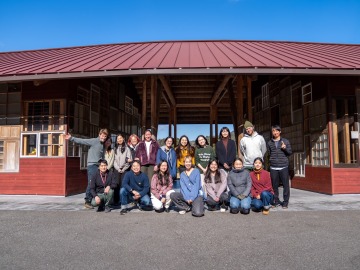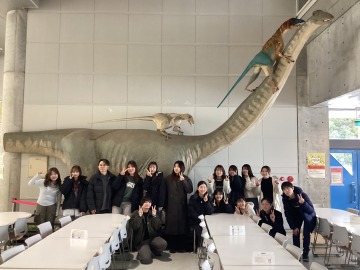Overview of Activities
Destination: Fukushima
Participants: 18 students (including 1 RA)
Period: August 20, 2025 (Wednesday) to August 23, 2025 (Saturday)
Activity Report
This is a training program offering multifaceted opportunities to learn about Fukushima’s recovery from the Great East Japan Earthquake and the Fukushima Daiichi Nuclear Power Plant accident, organized in cooperation with the Planning & Coordination Department of the Fukushima Prefectural Government.
Participants visited sites related to Fukushima’s reconstruction, including the TEPCO-operated Fukushima Daiichi Nuclear Power Station, the Great East Japan Earthquake and Nuclear Disaster Memorial Museum, Namie Town Ukedo Elementary School, and Futaba Town.
Experience Report from participant
FUKUSHIMA – What kind of image do you have when you hear the name “Fukushima?”. Probably you would think of the 2011 Tsunami and the nuclear power plant incident. But, how much do you know about the present Fukushima? I chose to attend this study trip because I wanted to learn more about Fukushima from various people’s perspectives, and how individuals have made efforts to recover from the disaster. In 2011, the Great East Japan Earthquake occurred, and a powerful Tsunami hit the coast. A nuclear power plant in Fukushima experienced a meltdown and caused serious damage to the Tohoku area. Many residents in Fukushima needed to leave their homes and start a new life outside the prefecture. I was 6 years old and living in Tokyo when this tragic disaster happened. I remember a big earthquake shook the land and continued for a while. We watched numerous TV programs that reported on Fukushima and its nuclear power plants. It is because of this that I took the chance through the SI trip to visit the site and listen to the people’s voices.
On the first day, we went to the The Great East Japan Earthquake and Nuclear Disaster Memorial Museum. We listened to a woman’s story about how she needed to leave her home for a while even though her house was safe. People in Fukushima were forced to move since the radiation level was high, and she told us how hard it was—and still is—to separate from her friends and neighbors for such a long time. The museum staff repeatedly asked us to spread the word about what happened in Fukushima; to not lose sight of its impact on its people, land, and society. Hearing this, I realized that remembering this event also helps us not forget about the importance of cooperating with each other.
After the museum, we went to an elementary school, which is now designated as a disaster heritage site. This school is known because every student and teacher managed to evacuate safely before the Tsunami hit the building. Everybody thought it was a miracle, and so the Fukushima Prefectural Government decided to register it as a heritage site. Because its interior was mostly destroyed by the big wave, it has been preserved in this state in a way to convey the memory of the disaster.
On the second day, our visit included the TEPCO-operated Fukushima Daiichi Nuclear Power Station, Asano Nenshi Futaba facility, the town of Futaba, and Futaba Future High School. At the Nuclear Power Station, most of the fuel debris remains unrecovered, and there is still no clear outlook on when full restoration will be possible. After going through security screening, we were allowed to walk near the decommissioned site. I realized that seeing the landscapes with your own eyes instead of just watching it through the TV is a vital step in understanding its lasting effects in Fukushima and its people.
On the third day, we visited a kiwi farm run by a young man who had just graduated from a university in Tokyo. He told us how the land was abandoned, and the landowner couldn’t resume the work due to his old age. Even so, he had an optimistic attitude, thinking about how he could reuse the abandoned land effectively. He told us the importance of stepping outside our comfort zone and embracing new challenges. His way of thinking made us feel hopeful about Fukushima’s future. We also went to Odaka Pioneer Village, a house in Soma town, to meet more entrepreneurs starting businesses in Fukushima. We enjoyed talking about Fukushima’s future possibilities with them. We learned that if there are jobs, people are likely to come back, and if this expands further, the town will be livelier and more active.
On the final day, we went to see tourist spots such as the Aquamarine Fukushima and Lala Mew, then did a cycling tour around the coast. At the aquarium, we saw a shocking video of the tsunami invading the facility. One worker who was there at the time told me that some people were laughing because they could not process what was happening. Fortunately, thanks to the great efforts of the workers and volunteers in Fukushima, the aquarium only took four months to reopen. There, we enjoyed seeing many sea creatures such as turtles, sharks, and seals.
We had lunch at Lala Mew, which is located very close to the Aquamarine Fukushima, and is a fish market where you can also shop for gifts and eat fresh food. The seafood rice bowl was delicious. Finally, before going back to our dorm, we cycled around the Hamadōri. It was incredibly refreshing. We had a nice time before our trip ended.
This 3-day 4-night program was a valuable experience for all of us. Being able to meet various people while travelling together with other WISH participants broadened my perspective on Fukushima and its inhabitants. Aside from the objective of the trip, I was also able to make many precious friends and share many conversations with them. I hope many other students can experience this opportunity in the future.
Thank you so much for reading my SI trip report. If you are considering joining WISH one day, I hope to see you in the SI class!
Chitose Shindoh














